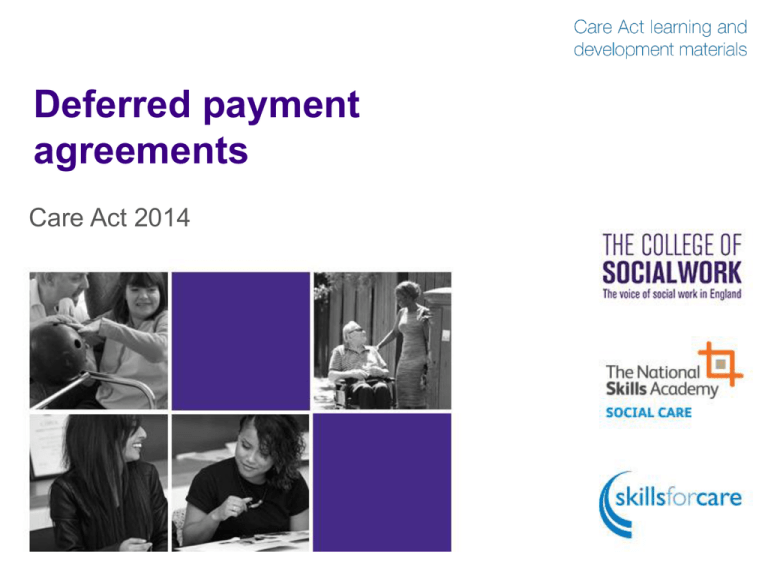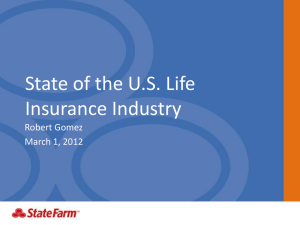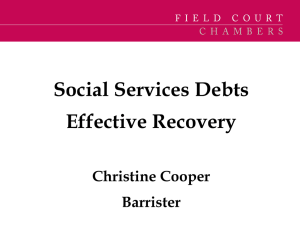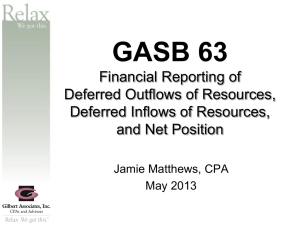Deferred payment agreements slide pack
advertisement

Deferred payment agreements Care Act 2014 Outline of content Introduction Eligibility for a deferred payment Information and advice How much can be deferred? Making the agreement Interest rates and charges Termination of the agreement Summary 2 Introduction The Act places a duty on all local authorities to operate a deferred payment scheme and to offer deferred payments to people meeting the acceptance criteria for the scheme By taking out a deferred payment agreement (DPA), a person can ‘defer’ or delay paying the costs of their care home until a later date A deferral can last until death, however people may choose to use a deferred payment agreement as a ‘bridging loan’ to give them time and flexibility to sell their home when they choose to do so Payment is deferred and not ‘written off’. This must be stressed to the individual 3 Paying for care and support A person could meet the costs of their care and support from a combination of any of four primary sources: Income, including pension A financial product Savings or other assets A Deferred Payment Agreement 4 Who is eligible for a deferred payment agreement? A deferred payment agreement (DPA) must be offered to anybody who has ‘adequate security’ and: Whose needs are to be met by the provision of residential care Who has less than the upper capital limit in assets excluding the value of their home Whose home is not occupied by a spouse or dependent relative However, some discretion may be exercised – local authorities may offer DPAs to others who don’t meet the criteria, including people in supported living accommodation Permission may be refused in certain circumstances e.g. where there is insufficient security 5 Adequate security A local authority must have adequate security in place when entering into a DPA They must accept a ‘first legal mortgage charge’ as adequate security and they have discretion to accept other security The security should be revalued periodically 6 Exercising discretion Local authorities can offer DPAs to people in residential care who do not meet the criteria. For example: If someone would like to use wealth tied up in their home to fund reasonable top-ups If someone has other accessible means to help them meet the cost of their care and support If a person is narrowly not eligible e.g. because they have slightly more than the asset threshold Local authorities may offer DPAs to people in extra care settings in some circumstances 7 Refusing a deferred payment agreement A local authority may refuse a request for a DPA in certain circumstances This is intended to provide local authorities with a reasonable safeguard against default or non-repayment of debt e.g. where: the local authority is unable to secure a first mortgage charge on the property someone wishes to defer a larger amount than they can sustainably afford a person’s property is uninsurable and they are unable to provide adequate security 8 Refusal to defer any more charges A local authority may refuse to defer any more charges for a person who has an active DPA for example: when a person’s total assets fall below the level of the means test and the person no longer needs to defer their care costs where a person no longer has relevant residential care (or where appropriate extra care) needs where a spouse or dependent relative has moved into the property after the agreement has been made where a relative who was living in the property at the time of the agreement subsequently becomes a dependent relative Local authorities must also cease deferring further amounts when a person has reached the ‘equity limit’ setting out the maximum that they they are allowed to defer 9 Information and advice The local authority should tell people about the DPA scheme and how it works, if they feel someone might benefit from having a DPA The explanation should include: The criteria for obtaining a DPA and the requirements Interest and admin charges The types of security that the authority is prepared to accept Implications for income, benefit entitlements and charging Termination of the DPA and options for repayment What happens if the person doesn’t repay The overall advantages and disadvantages of DPA The suggestion that people may want to consider taking independent financial advice. 10 Information and advice The local authority should also: Consider potential issues around loss of capacity, and offer advice on options for deputyship, legal power of attorney and advocacy Advise people that they will need to consider how they plan to use, maintain and insure their property Keep people informed about the DPA as it continues and provide necessary information on termination 11 How much can be deferred? Security Sustainability 12 Making the agreement When With whom Documentation 13 Interest rate and administration charge The DPA scheme is intended to be run on a cost-neutral basis, with local authorities able to recoup: the costs they may incur in deferral of charges via an interest rate administrative costs associated with DPAs Local authorities will have the ability to charge interest on any amount deferred Local authorities should maintain a publicly-available list of administration charges that a person may be liable to pay 14 Termination of the deferred payment agreement Voluntary repayment Sale of property /security Death 15 Summary Local authorities have a duty to operate a deferred payment scheme and are required to offer DPAs when the person: has adequate security meets the acceptance criteria for the scheme, and will agree to the DPA terms and conditions Additionally, local authorities have a fairly broad discretion including: extending DPAs to extra care settings; agreeing top-ups; and of the security they will accept The amount that can be deferred is dependent on there being adequate security, and whether the amount deferred is sustainable Interest on deferred costs, and administrative costs can be charged, but the scheme should run on a cost neutral basis 16











